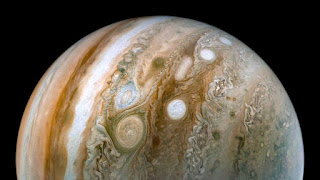Peering Deep Into the DESIGN of Jupiter---what purpose this DESIGN serves we will not fully know in this life...but interesting to ponder.... Hath in these last days spoken unto us by his Son, whom he hath appointed heir of all things, by whom also he made the worlds; Heb.1:2
"Data from the microwave radiometer carried by NASA’s Juno spacecraft shows that Jupiter’s banded pattern extends deep below the clouds, and that the appearance of Jupiter’s belts and zones inverts near the base of the water clouds.
At altitudes shallower than five bars of pressure (or around five times the average atmospheric pressure on Earth), the planet’s belts shine brightly in microwave light, whereas the zones are dark. But everything changes at higher pressures, at altitudes deeper than 10 bars, giving scientists a glimpse of an unexpected reversal in the meteorology and circulation.....and that the mid-latitude bands not only extend deep, but seem to change their nature the further down you go.At the cloud tops, Jupiter’s belts appear bright with microwave emission, while the zones remain dark. Bright microwave emission either means warmer atmospheric temperatures, or an absence of ammonia gas, which is a strong absorber of microwave light.
This configuration persists down to approximately five bars. And at pressures deeper than 10 bars, the pattern reverses, with the zones becoming microwave-bright and the belt becoming dark. Scientists therefore believe that something – either the physical temperatures or the abundance of ammonia – must therefore be changing with depth.
There are two possible mechanisms that could be responsible for the change in brightness, each implying different physical conclusions.
One mechanism is related to the distribution of ammonia gas within the belts and zones. Ammonia is opaque to microwaves, meaning a region with relatively less ammonia will shine brighter in Juno’s observations. This mechanism could imply a stacked system of opposing circulation cells, similar to patterns in Earth’s tropics and mid-latitudes.
These circulation patterns would provide sinking in belts at shallow depths and upwelling in belts at deeper levels – or vigorous storms and precipitation, moving ammonia gas from place to place.
Another possibility is that the gradient in emission corresponds to a gradient in temperature, with higher temperatures resulting in greater microwave emission.
Temperatures and winds are connected, so if this scenario is correct,
then Jupiter’s winds may increase with depth below the clouds until we
reach the jovicline, before tapering off into the deeper atmosphere –
something that was also suggested by NASA’s Galileo probe in 1995, which
measured windspeeds as it descended under a parachute into the clouds
of Jupiter." SciTechDaily

